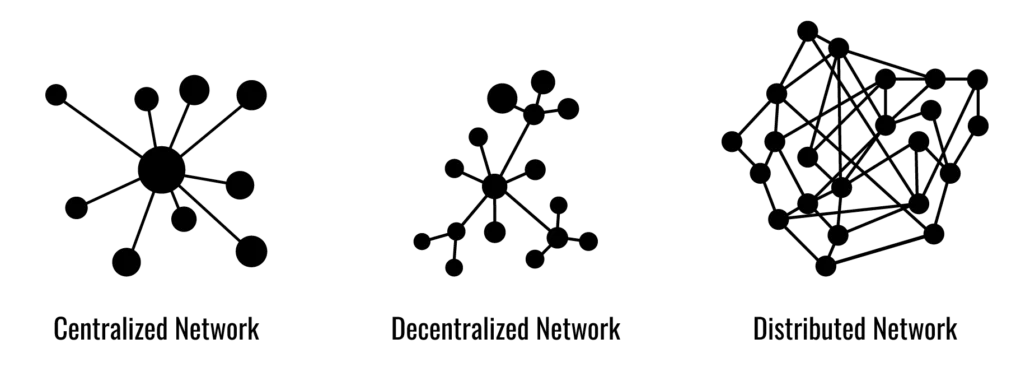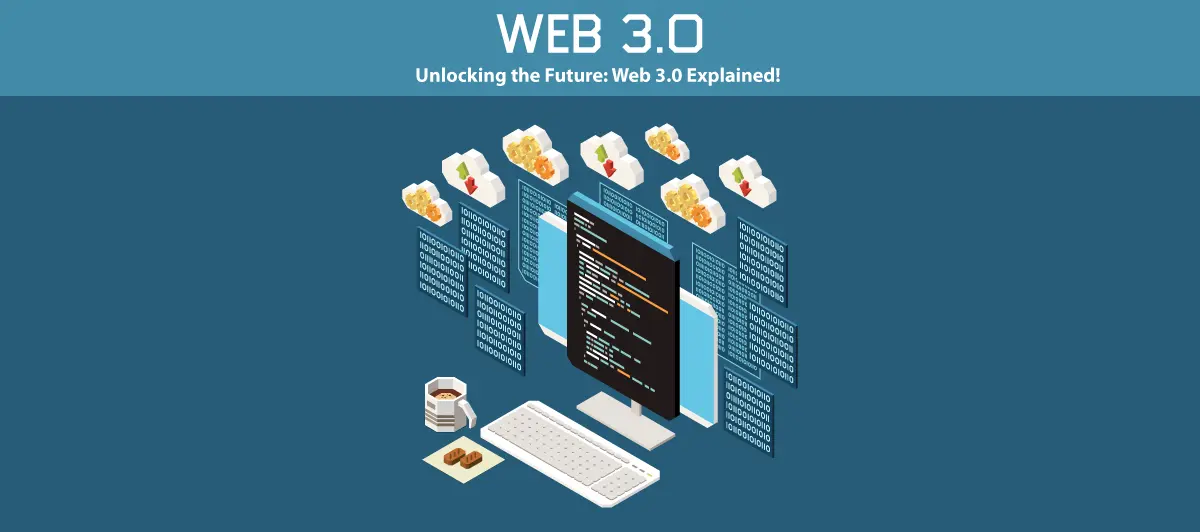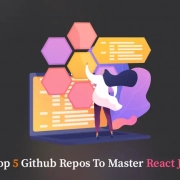What Is Web 3.0? Why Web 3.0 is the Future?
Quick Summary:You can’t say you haven’t heard of Web 3.0 technology, But do you know what it means and why it’s the future? Web 3.0, the Semantic Web, is the next evolutionary step in developing the Internet. It uses new technologies to improve how we access information on the Internet and how we interact. Before we start, we should know about Web 1.0 and Web 2.0.
Introduction
The Internet’s ever-evolving landscape anticipates a profound transformation is Web 3.0 technology.
Additionally, this paradigm shift promises to reshape how we interact with the digital realm. It offers a tantalizing glimpse into a more decentralized, secure, and user-centric internet ecosystem.
Furthermore, Web 3.0 signifies the next evolutionary stage of the World Wide Web, where data, services, and applications do not merely reside in centralized silos. But blockchain technology, artificial intelligence, and advanced protocols interconnect them.
But what does this revolutionary leap mean for web development services and app development?
How can businesses and developers harness the power of Web 3.0 technology to create innovative and user-centric solutions?
In this blog, we’ll delve deep into the captivating world of Web 3.0, exploring its potential to reshape the digital landscape. We’ll also uncover how the Best Web Development Services adapt to this new era, empowering businesses to thrive in the future of the web.
Keep reading and know all about Web App Development!
What are Web 1.0 and Web 2.0?
Web 1.0 is a content delivery network (CDN) that allows websites to present information. It is used as a personal website. With Web 1.0 services, information is presented using static Web pages (mostly hard-coded HTML pages) with minimal user interaction.
The internet is currently in a Web 2.0 condition. It is simply an updated version of web 1.0. It is unable for users to create, share, collaborate and communicate their work with each other without any need for design or publishing skills.
Why do we need web 3.0?
In simple words, if you wanna start a startup and it can compete with big giant businesses. It would be preferable to do that.
Problems with web2.0
-
No competition
In web 2.0 there is no competition, they control the internet. All traffic goes through Google, Microsoft, Facebook, yahoo, amazon, etc. These companies have the most money also they have all your data, and they have the best talent to create the best algorithm. They have the most computing power.
So how is anyone competing with them because they have everything, they have all the resources? So how are you supposed to start a startup?
-
Shrinking economy
With the rise of the industries the rise in the services the rise in the valuation of computing data they grow bigger and bigger.
Suppose you are a music creator then you have to publish your music with any web services like Amazon, youtube, or any other platform. So basically your creation is sold by commission agents. They take lots of commission. So your earnings go continuously down over the years.
-
Data Privacy
In this case, you are providing your whole data access and they returning you some of the free services. By using your data they will spy on you, advertise to you, and overall profit from you.
For example, if you were talking to your friend other days on any topic and you get an advertisement related to that topic. So here they are taking all your data through messenger, google home, etc. because we permitted them to do that. So they will make a profit from over data.
-
Accountability
All the major companies partnered with NSA and they are sharing our data with NSA. Big IT corporations provided NSA with private information. They are sharing our email, chat, videos, photos, stored data, file transfer, and Social network with NSA. and can’t do anything. there is no transparency about what these services are doing with our data. You just give them all your data and they can do anything with your data.
Facebook, for instance, optimizes its news feed for your attention because it drives ad revenue. They are showing content that catches your eye, but they don’t show what is relevant to you.
-
AGI(Artificial general intelligence)
We have so many problems in the world and we can solve them with AI.
AI is a control system that has a controller and they have a state they have systems for sensing the world. Today, we store AI on a server and have complete control over it. What does it matter if we let it go free in the world to make its own choice? Therefore, we desire a decentralized system that is uncontrollable by anyone.
To create a DAO (distributed autonomous organization). It is a new way of making companies or entities online. If we link these two technologies together, AI and blockchain, we can see that AI is getting its missing link resources like a Blockchain And Cryptocurrency that doesn’t depend on any central third party. The DAO blockchain brings its missing link in autonomous decision-making, so we combine these things and create something like a living entity that lives on the web.
-
Data permanence
There is the idea of book burning. Burning books was frowned upon during the Middle Ages. It was considered one of the worst things that anybody can do because books were the store of information. So it is a very bad thing. So nowadays we stored data that can be lost over time. It is stored in a data server and it can go down maybe there is a backup but ideally all data is replicated hundreds of times across the web. So we can’t never and ever destroy data.
So now, What are a Centralized network, Distributed Network, and a Decentralized network?

-
Centralized network
Where the main all the other peoples or computers rely on a single server.
-
Distributed Network
There it could still be centralized but it is not just dependent on a single person or computer or server. It can be distributed.
For Example Facebook, Its type of system can be both centralized and distributed. There are multiple servers but it’s controlled by a single entity so it’s both centralized and distributed actress the world but it is still controlled by a single entity.
-
Decentralized network
It is a new type of system that was enabled by bitcoin. It was the first decentralized system. The system is independent of any one of those nodes, thus it will continue to function even if you remove one of them. This is the system that you cannot overthrow.
So can you make an application that is open source and profitable? That was never possible before but now it’s possible with blockchain.
Community governed/controlled application. All of the actions that we can perform inside of this network. We may build a structure utilizing the blockchain, and app users can choose to participate by saying, “Let me vote on what we should be doing.
We can create apps that are censorship-resistant. So didn’t get a rejection of certain apps because they don’t abide by Chinese law etc. so making a decentralized app no one can block your application.
What is blockchain and how does it work?
Blockchain is very popular nowadays. It consists of a series of blocks that each hold data. A team of researchers first described this technique in 1991.
It is a distributed ledger that is completely open to anyone. They have interesting properties. “After storing data in the blockchain, changing it becomes very difficult.”
So how does it work? There are many blocks inside each block, and each block contains some data, the hash of the league, and the previous block.
The data used to store the block depends on the type of blockchain. The hash identifies the league and its contents, and it’s always unique, just like a fingerprint. A block’s hash is determined after it has been produced. If you change something inside the league, it will cause the soup to change. So, a hash is very useful for detecting block changes. A block is not the same block if its fingerprint changes.
The third element inside the block is the hash of the previous block. This effectively establishes a chain of blocks, and this method contributes to the security of a blockchain.
Example
Suppose we have a chain that has 3 blocks. Thus, each block has the hash and the hash of the preceding block.
The prior block hash in the first block is. Therefore, the previous block hash in the second block and the last hash block in the third block is the first block hash. As a result, the first block, in this case, is a genius block since it lacks the block’s preceding hash. Suppose you tamper with the second block. This also changes the block’s hash. Due to the change in the second block’s hash, the third and remaining blocks can no longer store a valid hash of previous blocks.
Modern computers can calculate millions of hashes in a single second. As a result, tampering with a single block renders all subsequent blocks invalid. A blockchain’s security stems from its innovative use of hashing and the proof-of-work algorithm. Peer-to-peer distribution is another way that the chain protects itself.
What’s Now?
Now, if someone creates a new block. Everyone on the network receives the block. Afterward, each node checks the block for tampering. If everything is in order, each node adds this block to its own blockchain. A consensus is produced by the network’s whole nodes. They concur on the valid and invalid blocks. Other nodes in the network will reject blocks that have been tempered. Therefore, in order to successfully alter a blockchain, you’ll need to alter each block’s proof-of-work, control more than 50% of a peer-to-peer network, and alter all of the chain’s blocks. Then everyone will start to accept your modified block.
Blockchains are also constantly evolving. one of the newest advancements in the development of smart contracts. Based on certain conditions, these contracts can automatically exchange coins on the blockchain.
There is a lot of interest in the development of blockchain technology. Eventually, other uses of the technology developed, such as creating a digital notary or collecting taxes.
What is Web 3.0?
The third-generation Internet, also known as Web 3.0, is the next step in the World Wide Web’s evolution. It offers a data-driven semantic web that uses machine-based data understanding to give users a more intelligent and connected web experience.
Today’s Internet is immobile, unable to adapt to the unique needs of each user. We expect Web 3.0 to be more interactive and dynamic. It will reimagine the web experience with structural improvements, ensuring democratization across all elements of the Internet by incorporating artificial intelligence and blockchain technologies.
Some Indirect Benefits Of Web3.0
Web 3.0 eliminates the need for centralized servers by storing data securely and distributing it across numerous devices.
Powered by machine learning and artificial intelligence, Web 3.0 technology uses blockchain technology to create a highly decentralized web. Human communication in the real world is the result. Users maintain control over their data and material and can sell or trade it without losing ownership, jeopardizing their privacy, or relying on intermediaries. Using this business strategy, users can access a website anonymously.
The digitalization of assets via tokenization is critical to Web 3.0’s innovation. On a blockchain network, tokenization turns assets and rights into digital representations or tokens. It is possible to easily transfer crypto and fungible tokens between networks, resulting in a new business model democratizing money and commerce. Non-fungible tokens (NFTs) are data units that represent unique assets such as avatars, digital art, or trade cards that users can own and commercialize.
The primary distinctions between Web 1.0 and Web 2.0 are quite simple to spot. Users who utilize the former consult online pages passively and do not create their content in general. Users connect with sites (and each other) via social networking platforms, forums, and other means. The distinctions could be clearer in the Web 3.0 generation of the Internet.
Features Of Web 3.0
-
Semantic Web:
The next development in the development of the Internet is the Semantic Web. The Semantic Web enhances web technologies’ capacities to generate, share, and connect content via search and analysis by comprehending the meaning of words rather than keywords or numbers.
-
Artificial Intelligence (AI):
By combining semantic skills with natural language processing, computers may understand information at a human-like level, resulting in faster and more relevant outcomes. As a result, they grow more intelligent and better able to meet the needs of their users.
-
3D Graphics:
In Web 3.0, three-dimensional design is prevalent in websites and services. Museum guides, video games, eCommerce, and geospatial contexts are examples.
-
Connectivity:
Using semantic metadata, Web 3.0 connects information more efficiently. Consequently, a new level of user experience can be provided that utilizes all available data to enhance the user experience.
-
Ubiquity:
PCs and smartphones are not the only devices that offer access to the Internet. Web 2.0 is already widespread in many ways, but the emergence of IoT devices will give it a boost.
-
Decentralized:
In decentralized data networks, data is stored in a peer-to-peer network. Users are in charge of their data and digital assets, and online logins are secure and anonymous.
-
Edge Computing
All Web 3.0-based appliances, laptops, mobile devices, and sensors work together.
Web 3.0’s Advantages
1. Increased information interconnection: The semantic web will assist in the linkage of material on the internet. Searching that is successful.
2. More effective marketing
3. Improved Web browsing efficiency
4. Effective communication
5. Alter the way people engage with one another
The Disadvantages of Web 3.0:
1. Devices without increased functionality will be unable to access Web 3.0.
2. Web 1.0 sites will look extremely older.
3. It is difficult to understand for newcomers.
4. Devices that aren’t as advanced may be unable to handle 3.0.
5. There is a requirement for a privacy policy.
Conclusion
We have covered a lot of ground in this blog post, but hopefully, you now have a firm grasp on what Web 3.0 is and why it is the future of the Internet. While adjusting to a new way of doing things can be difficult, we are confident that Web 3.0 will bring many benefits to the Internet and the world in general that make the transition worth it. Thank you for taking the time to read our blog on Web 3.0; we appreciate your feedback and hope you found it helpful!
FAQ
Why is Web 3.0 the future?
Web 3.0 promises decentralized, secure, and user-centric experiences using blockchain and peer-to-peer technology. Furthermore, it aims to redefine trust, privacy, and ownership, enabling more equitable and innovative online interaction.
What is Web 3.0, and why is it important?
In Web 3.0, or Web 3, users will be able to access their own data and connect through decentralized networks.
How is Web 3.0 changing the world?
Web 3.0 technology combines machine learning, artificial intelligence, and blockchain in order to provide real-time human interaction. In addition, Web 3.0 will allow individuals to receive reimbursement for the time they spend online as well as own their data.
Why is Web 3 growing right now?
As blockchain technology projects emerge and online transactions become more transparent, secure, and private, Web3 is growing.
What is the biggest problem with Web3?
Scalability is a major concern when it comes to Web3. It is difficult to scale Web3 to the same extent as centralized web systems due to the decentralized nature of its transaction validation and integrity management.













